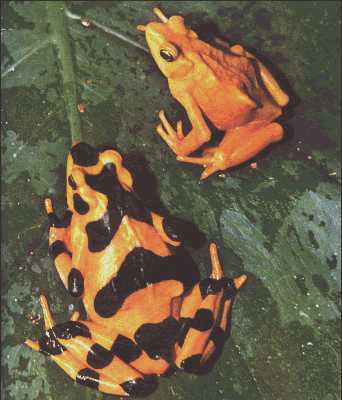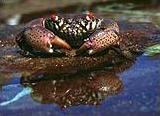Habitat
 T.
rubripes is found in marine habitat, mainly in the
Northwestern Pacific Ocean, the Sea of Japan, and the East China
Sea. The Japanese puffer fish adults live in the shallow inlet
waters and the brackish (mix of fresh water and sea water)
water leading to the Pacific. The adults can be found in the
shallow coral surrounding the coastal areas when laying their
eggs. Follow me to learn more about
puffer fish reproduction.
T.
rubripes is found in marine habitat, mainly in the
Northwestern Pacific Ocean, the Sea of Japan, and the East China
Sea. The Japanese puffer fish adults live in the shallow inlet
waters and the brackish (mix of fresh water and sea water)
water leading to the Pacific. The adults can be found in the
shallow coral surrounding the coastal areas when laying their
eggs. Follow me to learn more about
puffer fish reproduction.
The puffer fish share their waters with red claw crabs, seed shrimp, snails, Japanese large-eyed bream, sponges, anemones, and algea. The Japanese puffer fish stays in this area of the Northwestern Pacific because it is too small for the open ocean, and its food source (small marine species of crab, clams, snail and fish) are found here. Also the puffer fish is most happy within the semi-salt, semi-fresh water environment of the brackish waters. Follow me to learn more about how the puffer fish eats its food.
Once ingested the food passes directly into the intestine for digestion. The puffer fish also has a closed circulatory system, utilizing gills for gas exchange through the water.
The Japanese puffer fish is also one of many fish that can be infected with the parasite Heterobothrium okamotoi. The flatworm attaches its eggs to the puffer fish's body and its gills. When the larvae form, they burrow and eat away at the puffer fish, essentially killing the fish.
 The Japanese puffer fish
is thought to contain one of the bacteria that produce
tetrodotoxin as a biproduct, such as
Pseudomonas spp. or
Vibrio spp. Tetrodotoxin is a very strong neurotoxin
and has very adverse side effects for humans and other animals.
In humans, tetrodotoxin poisoning begins with numbness of the
lips and tongue, occurring within three hours of ingestion.
Numbness of the rest of the face, hands and feet follow, with
headache, nausea and vomiting after that. Paralysis, increased
respiratory stress, decreased speech, and cardiac arrhythmia
soon occur. Death occurs within 20 minutes to 8 hours of
ingestion.
The Japanese puffer fish
is thought to contain one of the bacteria that produce
tetrodotoxin as a biproduct, such as
Pseudomonas spp. or
Vibrio spp. Tetrodotoxin is a very strong neurotoxin
and has very adverse side effects for humans and other animals.
In humans, tetrodotoxin poisoning begins with numbness of the
lips and tongue, occurring within three hours of ingestion.
Numbness of the rest of the face, hands and feet follow, with
headache, nausea and vomiting after that. Paralysis, increased
respiratory stress, decreased speech, and cardiac arrhythmia
soon occur. Death occurs within 20 minutes to 8 hours of
ingestion.
Tetrodotoxin has been isolated from other
marine animals, including the California newt, parrotfish,
blue-ringed octopus, starfish, xanthid crabs, Harlequin frogs and angelfish.
Learn more about a cool parrotfish ,
Bullethead Parrotfish.

